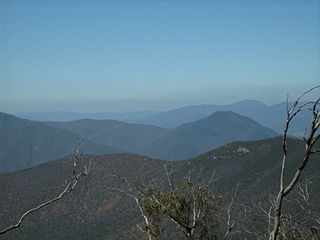Related Research Articles

The Australian Capital Territory (ACT), known as the Federal Capital Territory (FCT) until 1938, is a federal territory of Australia containing the Australian capital city of Canberra and some surrounding townships. It is located in the south-east of the country and is an enclave within the state of New South Wales. Founded after Federation as the seat of government for the new nation, all important institutions of the Australian Government are headquartered in the territory.
The Australian Capital Territory as of 2014 contains 46 separate protected areas with a total land area of 1,302 km2 (503 sq mi) or 55.5% of the territory's area, and which managed by Territory and Municipal Services of the ACT government:

Tidbinbilla Nature Reserve is a 54.5 square kilometres (21.0 sq mi) protected area, on the fringe of Namadgi National Park. Tidbinbilla is a short drive from the capital city of Australia, Canberra, in the Australian Capital Territory. It is the traditional Country of the Ngunnawal people.

The Canberra Deep Space Communication Complex (CDSCC) is a satellite communication station, part of the Deep Space Network of NASA's Jet Propulsion Laboratory (JPL), located at Tidbinbilla in the Australian Capital Territory. Opened in 1965, the complex was used for tracking the Apollo Lunar Module, and along with its two sister stations at Goldstone, California and Madrid, Spain is now used for tracking and communicating with NASA's spacecraft, particularly interplanetary missions. It is managed in Australia by the Commonwealth Scientific and Industrial Research Organisation (CSIRO).

The corroboree frogs are two species of small, poisonous ground dwelling frogs, native to Southern Tablelands of Australia. The two species are the southern corroboree frog and the northern corroboree frog. They are unique among frogs in that they produce their own poison rather than obtain it from their food source as is the case in every other poisonous frog species.

Conservation Volunteers Australia is an Australian not-for-profit conservation organisation that attracts and co-ordinates volunteers for environmental restoration projects.
Honeysuckle Creek Tracking Station was a NASA Earth station in Australia near Canberra, and was instrumental to the Apollo Program. The station was opened in 1967 and closed in 1981.

The history of the Australian Capital Territory (ACT) as a separate administrative division began in 1911, when it was transferred from New South Wales to the Australian federal government. The territory contains Australia's capital city Canberra and various smaller settlements. Until 1989, it also administered the Jervis Bay Territory, a small coastal region.
Graeme Thomas Barrow OAM was an Australian author best known for his bushwalking guide books and books on local history. Almost all his 28 books have been self-published through his business, Dagraja Press, established in 1977.

The Bimberi Nature Reserve is a protected nature reserve located in the Brindabella Range of New South Wales, in eastern Australia. The 10,868-hectare (26,860-acre) reserve is situated approximately 30 km (19 mi) south west of Canberra, which is in the Australian Capital Territory.

Mulligans Flat Woodland Sanctuary is a protected area situated in the Gungahlin district in north Canberra in the Australian Capital Territory. It has several trails for walking, running and cycling. The sanctuary functions as a fieldwork site for researchers studying native ecology.

Gibraltar Peak is a mountain with an elevation of 1,038 metres AHD that is located within the Tidbinbilla Nature Reserve, approximately 26.4 kilometres from Canberra, in the Australian Capital Territory of Australia. Gibraltar Peak is the 45th highest mountain in the Australian Capital Territory. There are two tracks leading up to the summit of the mountain, the longer being 13 kilometres (8.1 mi) and the shorter being 8 kilometres (5.0 mi).

Gibraltar Creek, a perennial stream that is part of the Murrumbidgee catchment within the Murray-Darling basin, is located in the Australian Capital Territory, Australia.

Paddys River, a perennial stream that is part of the Murrumbidgee catchment within the Murray-Darling basin, is located in the Australian Capital Territory, Australia.
Gibraltar Hill may refer to:

The Tidbinbilla River, a perennial stream that is part of the Murrumbidgee catchment within the Murray-Darling basin, is located in the Australian Capital Territory, Australia.

The ACT Rural Fire Service is a branch of the Australian Capital Territory Emergency Services Agency. It is responsible for the prevention, detection and extinguishment of all bushfires within the ACT, as well as assisting the other branches of ESA.

The Australian Alps National Parks and Reserves is a group of eleven protected areas consisting of national parks, nature reserves and one wilderness park located in the Australian Capital Territory, New South Wales and Victoria and which was listed as a "place" on the Australian National Heritage List on 7 November 2008 under the Environment Protection and Biodiversity Conservation Act 1999. The listing which covers an area of 16,531.80 square kilometres (6,382.96 sq mi), contains the vast majority of alpine and sub-alpine environments in Australia. The listing includes the following protected areas - Alpine, Baw Baw, Brindabella, Kosciuszko, Mount Buffalo, Namadgi and Snowy River national parks; the Avon Wilderness Park, and the Bimberi, Scabby Range and Tidbinbilla nature reserves.
Cortinarius jenolanensis is a fungus native to Australia. It was described in 2009 by Alec Wood, from a specimen collected at the Jenolan Caves on 30 April 1988. It has also been recorded from Tidbinbilla Nature Reserve in the Australian Capital Territory.

Corin Forest Mountain Resort is a commercial ski field and tourist destination located in the Tidbinbilla Range, south west of Canberra in the Australian Capital Territory. Situated in a mountain ash forest near the Namadgi National Park, in winter, it offers Australia's most northerly lifted ski area, and the closest to the national capital of Canberra. A 1.2 km mountain slide operates in the warmer months.
References
- ↑ "Tidbinbilla Nature Reserve Birrigai" (PDF). Government of the Australian Capital Territory. 2012. Retrieved 21 November 2020.
- ↑ "Landscapes around Canberra - Tidbinbilla" (PDF). Geological Society of Australia . Retrieved 21 November 2020.